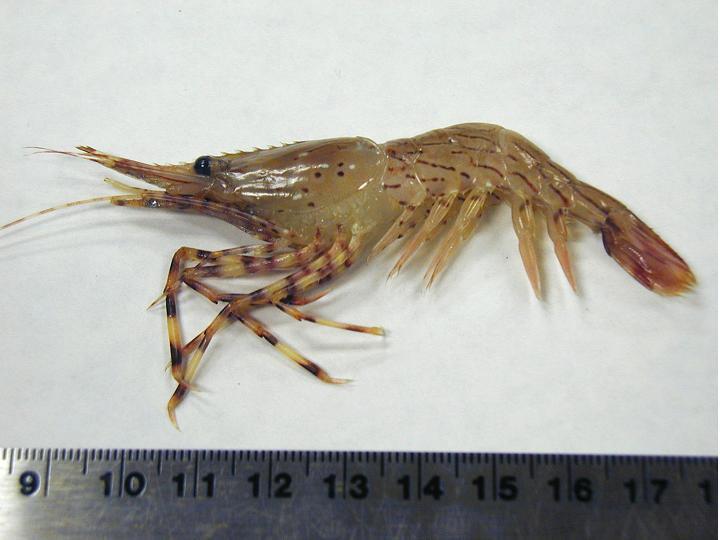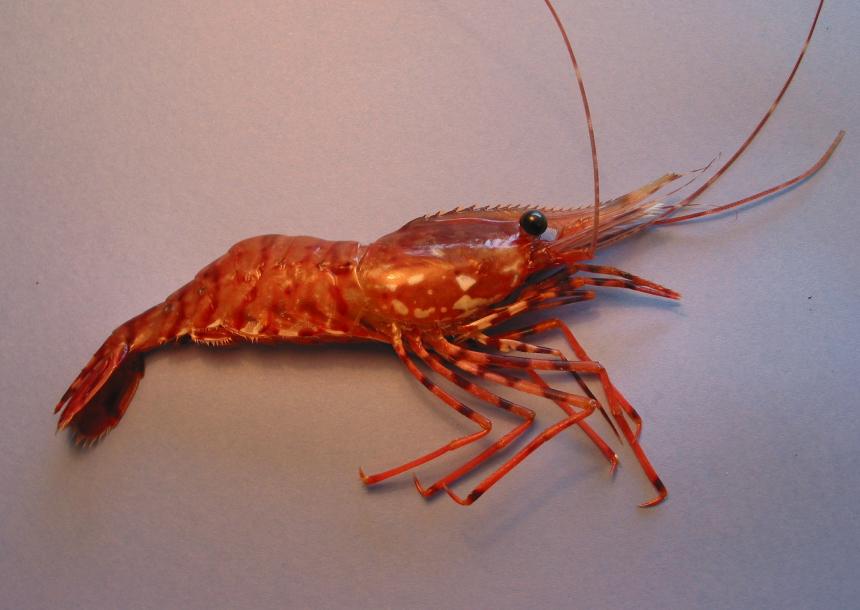Description and Range
Physical description
Dock (coonstripe) shrimp: A brownish shrimp with brown lines and spots on the head and tail, and may have small red or blue dots on the head. Dock shrimp seem to prefer areas of sand and gravel with swift tidal currents. Large individuals may reach 5 1/2 inches in length (14 cm), excluding the antennae.
Humpback (coonstripe) shrimp: This species of coonstripe shrimp is a mottled reddish-brown in color, with some white patches on the lower head and tail. There is a prominent ridge or hump on the head, with 17 to 21 spines running down the head and snout. This is the largest of the three coonstripes, and may attain lengths of up to 7 inches (19 cm), excluding the antennae.
Humpy (coonstripe) shrimp: The humpy is similar in appearance to the dock shrimp, except the stripes of the humpy are red to orange in color (compared to brown in the dock shrimp). This is a small shrimp, not exceeding 3 inches (7.5 cm) in length, excluding the antennae. Another key for identification is the third tail segment, which is enlarged, causing a definite humpback appearance. The spines do not extend to the outer half of the snout (rostrum).
Regulations
Licenses and permits
Shrimpers age 15 and older must have an annual shellfish/seaweed, combination or Fish Washington license. Licenses can be purchased online, by telephone at 866-246-9453, or at hundreds of license dealers across the state.
Rules and seasons
Shrimp Daily Limits and Rules
- Spot (Pandalus platyceros)
- Coonstripe (P. danae and P. hypsinotus)
- Pink (P. eous and P. jordani)
PUGET SOUND and HOOD CANAL
(Marine Areas 5-13 and Marine Area 4 east of the Bonilla-Tatoosh line).
Please see the regulations by marine area page for additional harvest dates and specific details.
Daily limit of 10 pounds, heads and tails, of all shrimp species combined (maximum of 80 spot shrimp, if open for spot shrimp).
If retaining only spot shrimp, then shrimp heads may be removed and discarded in the field.
If retaining any shrimp species other than spot shrimp, then shrimp heads may be removed but must be retained while in the field, until ashore and finished fishing for the day.
The minimum mesh size for shrimp pots is 1" mesh unless the area is closed for spot shrimp, but open for coonstripe and pink shrimp, then the minimum size for shrimp pots is 1/2" mesh (current gear rules).
In areas closed for spot shrimp, but open for coonstripe and pink shrimp, all spot shrimp caught must be returned to the water immediately.
PACIFIC OCEAN
(Marine Areas 1-3 and Marine Area 4 west of the Bonilla-Tatoosh line)
Pacific Ocean shrimp grounds are located a considerable distance from shore (30 miles or more) and as a result are generally inaccessible by the casual sport fisher.
DAILY LIMIT OF 25 POUNDS, heads and tails, of all shrimp species combined (maximum of 200 spot shrimp).
Shrimp heads may be removed, but must be retained while in the field, until ashore and finished fishing for the day.
The minimum mesh size for shrimp pots is 1" mesh (current gear rules).
ALL AREAS
Each harvester must have a separate container for their catch, either in their possession or identified with their name.
No minimum carapace size.
Maximum of two shrimp pots per person and no more than four shrimp pots per boat.
Prior to harvesting, check the Shellfish Rule Change free Hotline 866-880-5431 or check the online Emergency Rule Updates website for season closures and restrictions.
Locations
Dock shrimp: Common in the San Juan Islands, northern Puget Sound, and the Strait of Juan de Fuca.
Humpback shrimp: Commonly found in the Strait of Juan de Fuca, around the San Juan Islands, and in northern and central Puget Sound.
Humpy shrimp: Humpies are occasionally captured near the San Juan Islands.

